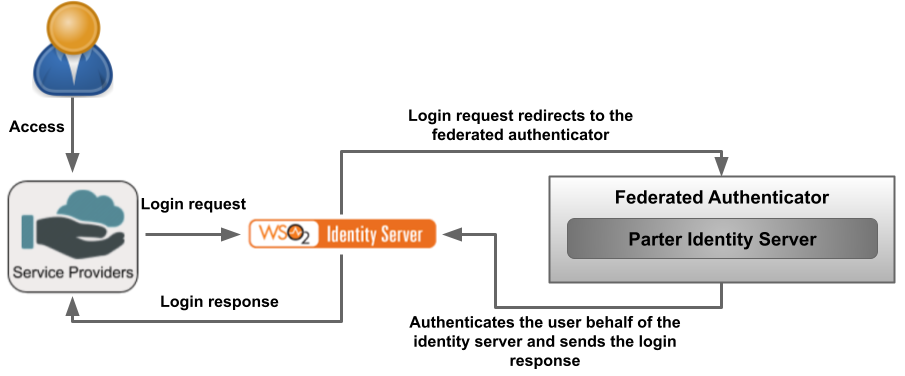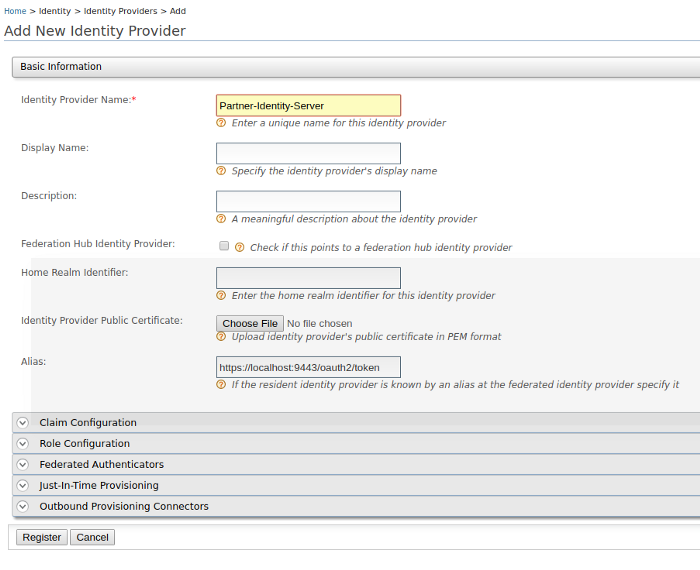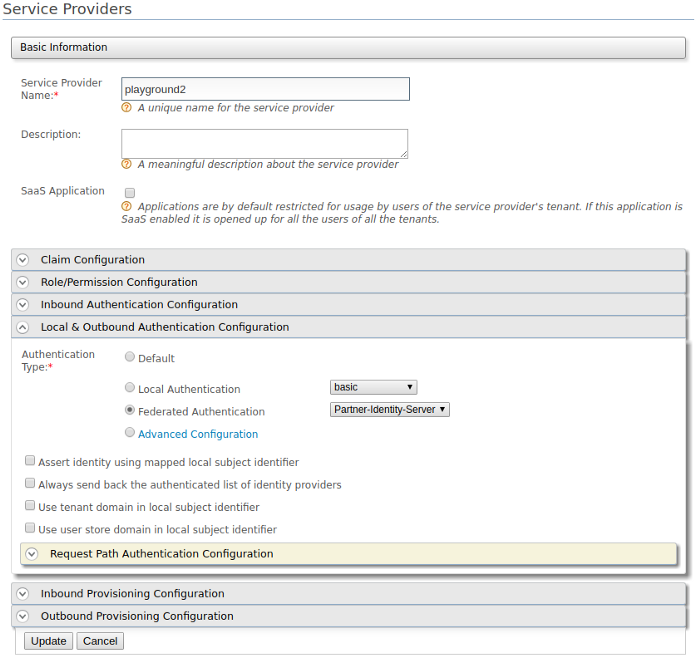This site contains the documentation that is relevant to older WSO2 product versions and offerings.
For the latest WSO2 documentation, visit https://wso2.com/documentation/.
Writing a Custom Federated Authenticator
A custom federated authenticator can be written to authenticate a user with an external system. The external system can be any Identity provider including Facebook, Twitter, Google, Yahoo, etc. You can use the extension points available in WSO2 Identity Server to create custom federated authenticators.
Authenticator API
The following is the API used to implement a custom federated authenticator.
/*
* Copyright (c) 2005-2013, WSO2 Inc. (http://www.wso2.org) All Rights Reserved.
*
* WSO2 Inc. licenses this file to you under the Apache License,
* Version 2.0 (the "License"); you may not use this file except
* in compliance with the License.
* You may obtain a copy of the License at
*
* http://www.apache.org/licenses/LICENSE-2.0
*
* Unless required by applicable law or agreed to in writing,
* software distributed under the License is distributed on an
* "AS IS" BASIS, WITHOUT WARRANTIES OR CONDITIONS OF ANY
* KIND, either express or implied. See the License for the
* specific language governing permissions and limitations
* under the License.
*/
package org.wso2.carbon.identity.application.authentication.framework;
import java.io.Serializable;
import java.util.List;
import javax.servlet.http.HttpServletRequest;
import javax.servlet.http.HttpServletResponse;
import org.wso2.carbon.identity.application.authentication.framework.context.AuthenticationContext;
import org.wso2.carbon.identity.application.authentication.framework.exception.AuthenticationFailedException;
import org.wso2.carbon.identity.application.authentication.framework.exception.LogoutFailedException;
import org.wso2.carbon.identity.application.common.model.Property;
/**
* API of the Application Authenticators.
*
*/
public interface ApplicationAuthenticator extends Serializable {
/**
* Check whether the authentication or logout request can be handled by the
* authenticator
*
* @param request
* @return boolean
*/
public boolean canHandle(HttpServletRequest request);
/**
* Process the authentication or logout request.
*
* @param request
* @param response
* @param context
* @return the status of the flow
* @throws AuthenticationFailedException
* @throws LogoutFailedException
*/
public AuthenticatorFlowStatus process(HttpServletRequest request,
HttpServletResponse response, AuthenticationContext context)
throws AuthenticationFailedException, LogoutFailedException;
/**
* Get the Context identifier sent with the request. This identifier is used
* to retrieve the state of the authentication/logout flow
*
* @param request
* @return
*/
public String getContextIdentifier(HttpServletRequest request);
/**
* Get the name of the Authenticator
* @return name
*/
public String getName();
/**
* @return
*/
public String getFriendlyName();
/**
* Get the claim dialect URI if this authenticator receives claims in a standard dialect
* and needs to be mapped to the Carbon dialect http://wso2.org/claims
* @return boolean
*/
public String getClaimDialectURI();
/**
* @return
*/
public List<Property> getConfigurationProperties();
}
This API can be used to configure a custom authenticator.
Writing a custom federated authenticator
- First create a maven project for the custom federated authenticator. Refer the pom.xml file used for the sample custom federated authenticator.
- Refer the service component class as well since the authenticator is written as an OSGI service to deploy in WSO2 Identity Server and register it as a federated authenticator.
- The custom federated authenticator should be written by extending the AbstractApplicationAuthenticator class and implementing the FederatedApplicationAuthenticator class.
The important methods in the AbstractApplicationAuthenticator class, and the FederatedApplicationAuthenticator interface are listed as follows.
Returns the name of the authenticator.
public String getFriendlyName() -
Returns the display name for the custom federated authenticator. In this sample we are using custom-federated-authenticator.
public String getContextIdentifier(HttpServletRequest request) -
Returns a unique identifier that will map the authentication request and the response. The value returned by the invocation of authentication request and the response should be the same.
public boolean canHandle(HttpServletRequest request) -
Specifies whether this authenticator can handle the authentication response.
Redirects the user to the login page in order to authenticate and in this sample, the user is redirected to the login page of the application which is configured in the partner identity server which acts as the external service.
Implements the logic of the custom federated authenticator.
You can find a custom federated authenticator here for your reference.
Deploy the custom federated authenticator in WSO2 IS
Once the implementation is done, navigate to the root of your project and run the following command to compile the service.
$ mvn clean install
- Copy
org.wso2.carbon.identity.custom.federated.authenticator-x.x.x.jarinside the/targetfolder to the<IS_HOME>/repository/components/dropinsfolder.
Configure the partner identity server
In this sample the partner identity server acts as the external system. Therefore, that partner identity server will be running on the same machine in a different port by changing the port offset to 1 in the <PARTNER_ file as given below.IS_HOME>/repository/conf/carbon.xml
<Offset>1</Offset>
After starting that partner identity server, it will run on localhost:9444
Register a service provider
In the Management Console of the partner identity server, navigate to Main > Identity > Service Providers > Add.
Enter a Service Provider Name. Optionally, enter a Description.
Click Register.
Expand Inbound Authentication Configuration > OAuth/OpenID Connect Configuration.
Add
https://localhost:9443/commonauthas the Callback Url.
Add a user
In the Management Console of the partner identity server, navigate to Main > Identity > Users and Roles > Add.
Click Add New User and create a new user by providing username and password.
Click Finish.
Configure the identity server
Configure the federated authenticator
In the Management Console of the identity server, navigate to Main > Identity > Identity Providers > Add.
Enter the Identity Provider Name as
Partner-Identity-Server.Click Register.
In the registered identity providers view, click Edit on the created identity provider.
Click Federated Authenticators and expand Custom-federated-authenticator Configuration.
Configure it as follows.
- Select Enable.
- Client Id - The Client Id generated by the external service provider of the partner identity server.
- Client Secret - The Client Secret generated by the external service provider of the partner identity server.
- Callback URL -
https://localhost:9443/commonauth - Authorization Endpoint URL -
https://localhost:9444/oauth2/authorize/ - Token Endpoint URL -
https://localhost:9444/oauth2/token/
Configure an application with the custom federated authenticator
Let’s use the playground app. Refer this to configure playground app.
In the created service provider, expand Local & Outbound Authentication Configuration. For the Authentication Type,
select Federated Authentication. Select the configured federated authenticator from the dropdown.Click Update to save the configurations.
Try the scenario
Access the playground app by using http://wso2is.local:8080/playground2/.
This will redirect to the login page of the application which is configured in the partner identity server which acts as the external service.
Enter the username and password of the earlier created user in the partner identity server.
Now the user is authenticated by the partner identity server.
Similarly, you can write a federated authenticator to authenticate the users using an external system.



